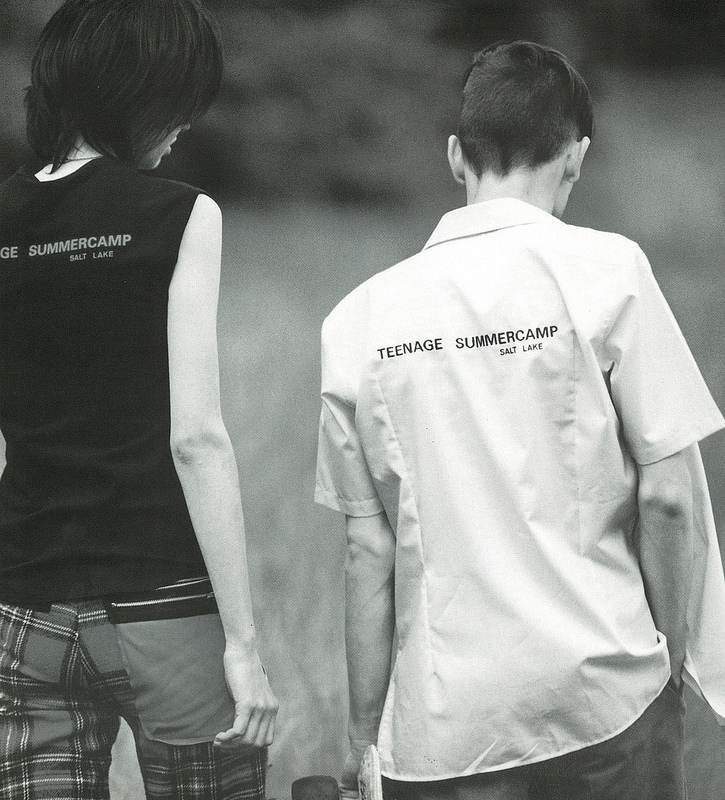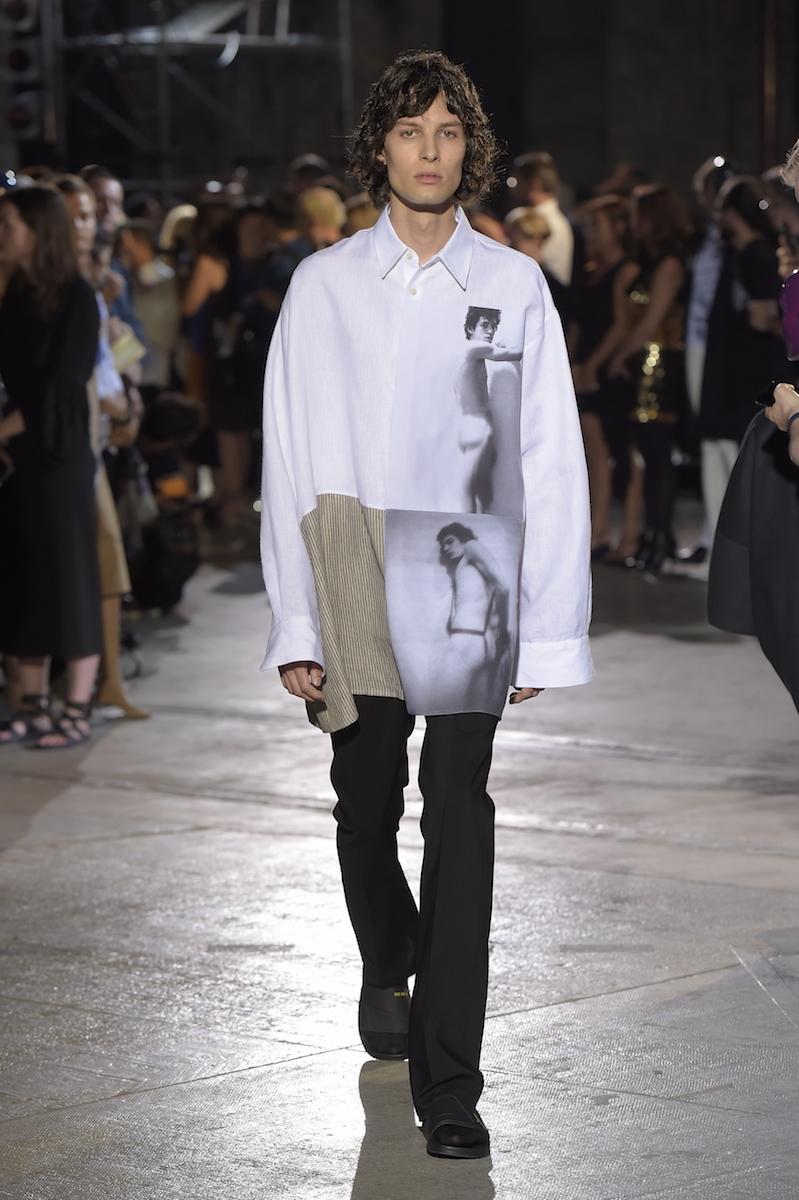Earlier this month, Raf Simons was officially unveiled as chief creative officer of American fashion behemoth Calvin Klein. The clues were there, if you looked hard enough — not just in the excited chatter of already-convinced editors, but in the clothes themselves.
At Pitti Uomo in Florence this June, Raf’s collection was overlaid with the photographs of Robert Mapplethorpe, the clothing becoming a frame for the American artist’s work. There was a male torso on a shirt, an erect cock on the back of a jacket, Mapplethorpe’s own topless self-portrait on a leather vest. Backstage, Raf likened it to an exhibition, a retrospective.
But what does Mapplethorpe have to do with Calvin Klein? A good question. Mapplethorpe is one of those quintessential American artists whose work is revisited again and again, just as Klein was one of those quintessentially American fashion designers. But here, what entwines the two is not the country of their birth but a fascination — an obsession even — with the male body.
Take first Mapplethorpe’s sensitive, erotic male nudes. They show masculinity as something ornamental — something that can be performed, slipped on and off when the camera snaps. It is the same idea that Calvin Klein has always traded on — the brand’s enduring campaigns hold up the male body to the same gaze that women have long been subjected to. Think back to a soaking wet Marcus Schenkenberg nude bar a pair of scrunched up jeans or Mark Wahlberg with his hands down his pants.
Fenton Bailey — who recently produced the HBO documentary Mapplethorpe: Look At The Pictures — argues that Calvin Klein’s aesthetic owes a lot to Mapplethorpe. “Without his male nudes, Calvin Klein never would’ve done that campaign with Mark [Wahlberg]. It’s impossible to imagine where we are today without him,” he says. “Shooting those sexually explicit selfies and saying these are art and forcing them to look at them was a huge step towards normalizing it so people could get over the shock. He was a disrupter.”

When it comes to Raf though, and a hint of what his Calvin might look like, this is all conjecture. But whether or not he was sending a message about his future career move doesn’t really matter — the link still speaks to a conversation about masculinity that has long run through American menswear. There has been the preppy sportiness of Ralph Lauren or Tommy Hilfiger; the pumped-up, homoerotic imagery of Bruce Weber for Abercrombie and Fitch. You can even see it in Helmut Lang’s relentless minimalism, whose legacy Raf works under. Lang presented a vision of American menswear that spoke with the interplay between men’s and women’s dressing.
Raf, too, has been fascinated by manhood, expressing it in various ways throughout his highly influential career. An early collection, spring/summer 99, was entitled Teenage Summer Camp, and spoke of boys in the naive bloom of youth. In later collections this idea was dragged through the filter of subcultures — sexually transgressive post-punk Britain, the androgyny of David Bowie’s Thin White Duke, Kraftwerk’s industrial masculinity.
For fall/winter 16 (the collection before he showed at Pitti Uomo, and the first since his liberation from Dior) he looked towards the American male for inspiration. A list of references was handed out to journalists before the show (“have I not told you them all already?” when people pressed him backstage). They read: Detroit, Tulsa, Twin Peaks, and Elm Street, amongst others. Here, the male body was expanded and warped — huge football sweaters frayed at the edges, giant puffer jackets. It referenced the uneasiness of the United States, a place far removed from the shiny American dream.
But now, Raf finds himself head of Calvin Klein, an American company worth $8 billion. It is probably his most important role to date — replacing Italo Zuchelli, Francisco Costa, and Kevin Carrigan, who worked on menswear, womenswear, and jeans respectively. He will also oversee perfumes and ad campaigns, affording him a singular creative vision that his was never allowed at Dior, something that famously frustrated him.
It is also set to be his most influential role. American fashion has failed in finding a distinct place in the season’s schedule — where Paris and Milan have the wealth and power of houses and conglomerates, and London the famed creative buoyancy, America has struggled to find a designer or voice to define their times. Marc Jacobs has come close, so too has Alexander Wang, but neither of these provide a menswear collection nearly as high profile as their womenswear offering. Raf has the power to inject American menswear, and womenswear for that matter, with a much-needed boost.

One hopes that Raf brings these ideas of subversion that have long defined his work to the American market. But he will not work in isolation. While there is ostensibly stagnation in the big American houses (DKNY was the latest casualty, sold off by LVMH after failing sales) younger American brands are creating excitement beneath the surface — finding inspiration from similar places that Raf long has.
The most obvious example is probably Hood By Air, whose shows embrace different colors, sizes, and body shapes and whose designs mine the underground queer scene (the brand’s last show in Paris was held in the basement of a gay sauna), reimagining masculinity in a vital, virile way. Here, feminine meets masculine in a powerful clash — like those red, thigh-high boots that on the male models didn’t weaken but strengthen, the extra height making them fearsome, threatening. It may show its menswear collections in Paris but that American-ness is still there — the streets of New York reverberate through the clothes.
Other dissenting voices are also emerging. Gypsy Sport and Devon Halfnight LeFlufy held attention during the last New York Men’s Fashion Week with a play on what American menswear can mean. The latter invited attendees into a strange virtual reality world where abstract images sourced from dark corners of the internet were printed across the collection and combined with bondage harnesses. The former warped the masculine code of the football uniform, adding lace and fringing, challenging the boundaries of male dressing. Previously, Gypsy Sport staged a guerrilla show in Washington Square Park. It was an excitement that New York has been missing for a while.
That said, the rest of the designers at New York Fashion Week: Men’s continued to mull over well-charted territories of American sportswear. So the challenge remains — can Raf bring American menswear back to life? Maybe. Probably. Either way, he will change its course, as he has long been able to. And what that will look like with an $8 billion fashion empire behind him? Well, that just remains to be seen.
Credits
Text Jack Sunnucks
